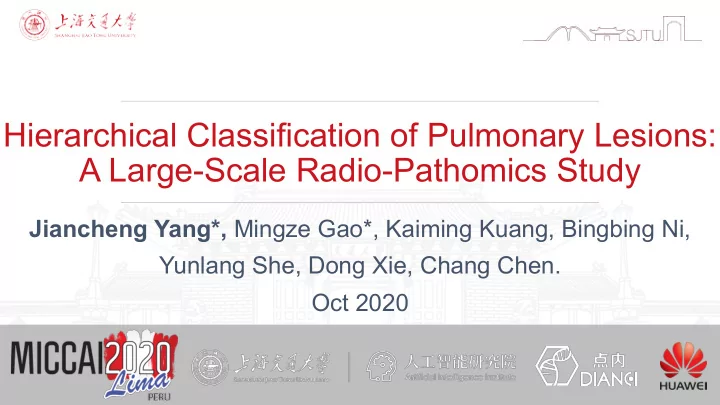

Hierarchical Classification of Pulmonary Lesions: A Large-Scale Radio-Pathomics Study Jiancheng Yang*, Mingze Gao*, Kaiming Kuang, Bingbing Ni, Yunlang She, Dong Xie, Chang Chen. Oct 2020
Introduction Medical image annotation is very ambiguous due to • Expertise of annotators On LIDC-IDRI, the largest public • Imaging issues database for lung nodule diagnosis, only ~1,183 out of 2,635 ( <50% ) • Inherent issues nodules are diagnosed consistently by 4 radiologists. • … How to reduce the annotation ambiguity from human experts? Probabilistic Radiomics: Ambiguous Diagnosis with Controllable Shape Analysis. Jiancheng Yang et al. MICCAI'19 Introduction – Methodology – Experiments – Conclusion
Introduction Use pathologically confirmed labels (clinical golden standard)! Introduction – Methodology – Experiments – Conclusion
Introduction Use pathologically confirmed labels (clinical golden standard)! Our in-house dataset Pulmonary-RadPath • Large-scale • Hierarchical • Multi-Disease Introduction – Methodology – Experiments – Conclusion
Methodology: Pulmonary-RadPath All data is collected from a single clinical center: Shanghai Pulmonary Hospital , Tongji University, Shanghai, China. Introduction – Methodology – Experiments – Conclusion
Methodology: Hierarchical Classification Take-Home : • Learn each hierarchy with separate head • Keep a Leaky Node as a virtual class for “ others ” • Make densely connected hierarchies Introduction – Methodology – Experiments – Conclusion
Experiments • H1: Cancer / Non-Cancer • H2: Cancer subtypes • H3: Non-Cancer subtypes • H4: Adenocarcinoma subtypes: invasive (IA) / non-invasive (non-IA) H4 prior arts: 88.0 / 92.0 / 92.1 3D Deep Learning from CT Scans Predicts Tumor Invasiveness of Subcentimeter Pulmonary Adenocarcinomas Wei Zhao*, Jiancheng Yang* , Yingli Sun, Cheng Li, Weilan Wu, Liang Jin, Zhiming Yang, Bingbing Ni, Pan Gao, Peijun Wang, Yanqing Hua, Ming Li. Cancer Research (IF-9.130), 2018 Introduction – Methodology – Experiments – Conclusion
Conclusion • We build a large-scale in-house Radio-Pathomics dataset, named Pulmonary-RadPath : 5,134 radiological CT images with pathologically confirmed labels. • We develop the first hierarchical multi-disease classification system of pulmonary lesions. • The discriminative performance is impressive compared to prior arts. • Limitation: • Data bias: pathological analysis is performed on high-risk subjects. • Long-tailed: certain disease types are naturally very long-tailed. Introduction – Methodology – Experiments – Conclusion
Thanks for Listening Check out my home page WeChat for materials on this study jekyll4168 https://jiancheng-yang.com/
Recommend
More recommend